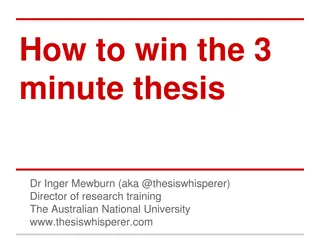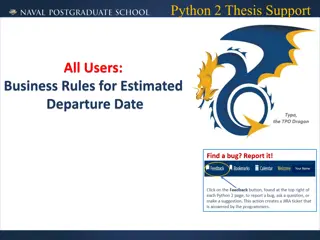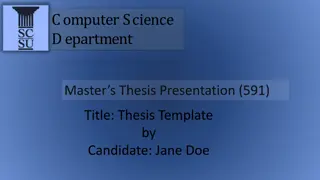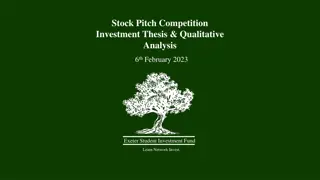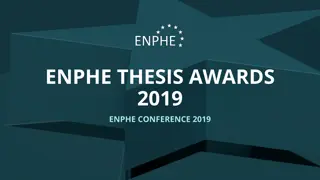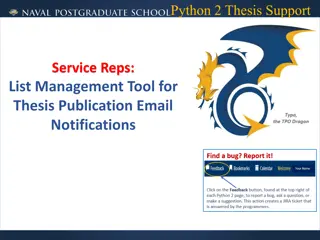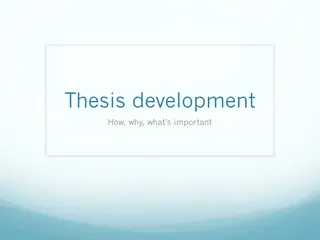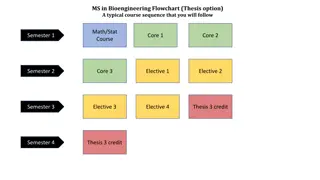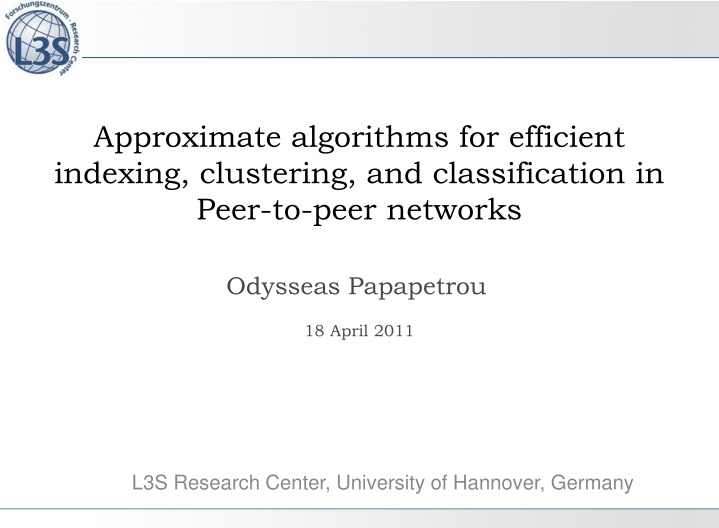
Efficient Indexing, Clustering, and Classification in P2P Networks
Explore approximate algorithms for efficient indexing, clustering, and classification in Peer-to-peer networks. Discover application scenarios, challenges, and approaches in maintaining inverted indexes, text clustering, and near-duplicate detection. Learn about information retrieval and data mining in P2P networks and the dynamics of unstructured P2P networks.
Uploaded on | 2 Views
Download Presentation

Please find below an Image/Link to download the presentation.
The content on the website is provided AS IS for your information and personal use only. It may not be sold, licensed, or shared on other websites without obtaining consent from the author. If you encounter any issues during the download, it is possible that the publisher has removed the file from their server.
You are allowed to download the files provided on this website for personal or commercial use, subject to the condition that they are used lawfully. All files are the property of their respective owners.
The content on the website is provided AS IS for your information and personal use only. It may not be sold, licensed, or shared on other websites without obtaining consent from the author.
E N D
Presentation Transcript
Approximate algorithms for efficient indexing, clustering, and classification in Peer-to-peer networks Odysseas Papapetrou 18 April 2011 L3S Research Center, University of Hannover, Germany
Introduction Application scenarios of Peer-to-peer File sharing, IP telephony, video streaming, data analysis, collaborative spam filtering, Frequent building blocks Information retrieval Data mining Challenges Large networks High churn High network cost Approximate Algorithms for Efficient Indexing, Clustering, and Classification in P2P networks 2
Introduction Information retrieval and data mining in P2P networks Information retrieval Maintaining an inverted index for keyword search Near-duplicate detection Data mining Clustering over a P2P network Classification over a P2P network Approximate Algorithms for Efficient Indexing, Clustering, and Classification in P2P networks 3
Outline Introduction PCIR: Maintaining the inverted index for keyword search Related work Basic PCIR Clustering-enhanced PCIR Experimental evaluation PCP2P: P2P text clustering Related work PCP2P Experimental evaluation Brief summary POND: P2P near duplicate detection CSVM: P2P classification Conclusions Approximate Algorithms for Efficient Indexing, Clustering, and Classification in P2P networks 4
Information retrieval over P2P The P2P information retrieval model Thousands of nodes, constantly changing! Standard users Digital libraries No central server! 12 days of christmas.mp3 christmas carol.mp3 athens.png chania.png crete.png winter hannover.png Google-style search football.txt tennis.txt basket.doc les miserables.doc recipes.pdf beautiful mind.avi recipes.doc the king speech.mpeg Approximate Algorithms for Efficient Indexing, Clustering, and Classification in P2P networks 5
Unstructured P2P networks Peers form a connected graph Query flooding with a time-to-live Synopses: Gnutella-QRP[Gnu], EDBFs [Infocom05],PlanetP [HPDC] Super peers: Gnutella 0.6, FastTrack [ComNet06], [ICDE03], [WWW03] Scalability to large networks and quality of results Rodrigues and Druschel: Good at finding hay, but bad at finding needles [CACM10] Approximate Algorithms for Efficient Indexing, Clustering, and Classification in P2P networks 6
Structured P2P over DHT Distributed Hash Tables (DHTs) Functionality of a hash table: put(key, value)and get(key) similar to centralized hash tables Chord: Peers organized in a ring structure Finger tables Peers establish links to peers with distance = i2 Similar to binary search Log(n) messages per DHT lookup Approximate Algorithms for Efficient Indexing, Clustering, and Classification in P2P networks 7
Structured P2P over DHT Term Football Peer Peer 13 Peer 6 Peer 11 ... Term freq. in peer 20 17 13 . List of relevant peers for each term Chocolate Peer 84 .... . ... . . DHT key DHT value State of the art vary in index granularity: Minerva Alvis sk-Stat, mk-Stat Approximate Algorithms for Efficient Indexing, Clustering, and Classification in P2P networks 8
DHT publishing steps Each peer extracts the frequencies for all its terms Each peer publishes its scores in the DHT inverted index One DHT lookup for each of its terms - log(n) messages Periodic execution IR and P2P 1. 2. 3. terms Cost per n peer # : log( ), n where : number of peers Approximate Algorithms for Efficient Indexing, Clustering, and Classification in P2P networks 9
Structured P2P over DHT DHT-based indexes for distributed search O(log(n)) per term lookup per peer Total publishing cost: 5000 peers, 1000 terms per peer: 61 million msgs log( (# )) O terms n n How to reduce the network cost Key insight: Some terms are very popular across peers! Can we exploit this to reduce the indexing cost? Approximate Algorithms for Efficient Indexing, Clustering, and Classification in P2P networks 10
PCIR: Peer Clusters for Inf. Retrieval Basic approach All peers are part of the global DHT Peers also form groups Each peer submits its index to its super-peer Super-peers perform: DHT lookups DHT updates for all distinct group terms Approximate Algorithms for Efficient Indexing, Clustering, and Classification in P2P networks 11
Updating the super-peers Step 1: Peer joins a group, or creates a group itself P17 Prob[newGroup]=0.1 Used to determine the ratio of peers/super-peers P17 Approximate Algorithms for Efficient Indexing, Clustering, and Classification in P2P networks 12
Updating the super-peers Step 2: Peers submit their terms to the group s super peer Peer 17 Term Peer Score Football Tennis . 20 27 . No DHT lookup required Approximate Algorithms for Efficient Indexing, Clustering, and Classification in P2P networks 13
Updating the DHT Term Football Peer Peer 17 Peer 13 Peer Score 20 17 Step 3: Super peer publishes the group s terms to the DHT Term Football Peer Peer 17 Peer 13 . . Peer Score 20 17 . . Tennis . Exploits term overlap! 1 DHT lookup per term per group Approximate Algorithms for Efficient Indexing, Clustering, and Classification in P2P networks 14
Updating the DHT Term Tennis Peer Peer 17 Peer 13 Peer Score 19 16 Step 3: Super peer publishes the group s terms to the DHT Term Football Peer Peer 17 Peer 13 . . Peer Score 20 17 . . Tennis . Exploits term overlap! 1 DHT lookup per term per group Approximate Algorithms for Efficient Indexing, Clustering, and Classification in P2P networks 15
PCIR algorithm Steps Peer joins a group or forms its own Peer submits its terms at the super peer of its group Super peer publishes the group s data to the DHT Steps 2-3 repeated periodically to compensate churn 1. 2. 3. Result: a superset of the SOTA inverted index no information loss Query execution as in the SOTA! Term Football Peer Peer 17 Peer 35 Peer 13 . . Peer Score 20 17 17 . . Super peer Peer 2 Peer 21 Peer 2 . . Tennis Approximate Algorithms for Efficient Indexing, Clustering, and Classification in P2P networks 16
How many super-peers? Tradeoff 1 super-peer only many super-peers maximum overlap super-peer gets overloaded not a P2P solution anymore less overlap low workload at super-peers Balance the super peer workload and term overlap User sets an acceptable load per super-peer Maximum network cost Analysis relying on network statistics number of super-peers Still high overlap Approximate Algorithms for Efficient Indexing, Clustering, and Classification in P2P networks 17
Clustering-enhanced PCIR Clustering-enhanced PCIR Cluster peers around similar peers to increase term overlap Larger term overlap fewer distinct terms per cluster even fewer DHT lookups Approximate Algorithms for Efficient Indexing, Clustering, and Classification in P2P networks 18
How to cluster the peers Clustering a peer: Peers and super-peers: term sets Bloom filters Peer selects the most promising super peers using the DHT, and sends its Bloom filter to them BFsp1 0 Pr[1000 overlap 1300] 9 . 0 5 0 1 1 0 1 0 1 1 BFsp2 0 Pr[1700 overlap 1850] 9 . 0 5 0 1 1 0 1 0 1 1 BFp BFsp3 1 Pr[8000 overlap 00] 4 8 9 . 0 5 0 1 1 0 1 0 1 0 BFsp4 Pr[1200 overlap 1400] 9 . 0 5 0 1 1 0 1 0 1 0 Probabilistic guarantees that the peer joins the best cluster Approximate Algorithms for Efficient Indexing, Clustering, and Classification in P2P networks 19
Evaluation Measures Average messages per peer Average transfer volume per peer More results in the thesis Datasets Reuters Corpus Volume 1, 160,000 articles Medline, 100,000 abstracts Comparisons Flat DHT indexing (e.g., Minerva, Alvis, mk-Stat, sk-Stat) Basic PCIR Clustering-enhanced PCIR Approximate Algorithms for Efficient Indexing, Clustering, and Classification in P2P networks 20
Network cost Vs super-peer workload Baseline (100%): Minerva peer granularity index Approximate Algorithms for Efficient Indexing, Clustering, and Classification in P2P networks 21
Network cost at super peers Flat DHT PCIR Basic PCIR Clustering 5000 4000 Transfer Volume (Kbytes) 3000 2000 1000 0 0 5000 10000 15000 20000 25000 30000 35000 40000 Maximum terms per super peer Approximate Algorithms for Efficient Indexing, Clustering, and Classification in P2P networks 22
PCIR: Indexing for keyword search Conclusions Basic and clustering-enhanced PCIR Exploit term overlap across peers Maintains the same inverted index as SOTA approaches No peer gets overloaded Odysseas Papapetrou, Wolf Siberski, Wolfgang Nejdl: PCIR: Combining DHTs and peer clusters for efficient full-text P2P indexing. Computer Networks 54(12): 2019-2040 (2010) Odysseas Papapetrou, Wolf Siberski, Wolfgang Nejdl: Cardinality estimation and dynamic length adaptation for Bloom filters. Distributed and Parallel Databases 28(2): 119-156 (2010) Odysseas Papapetrou. Full-text Indexing and Information Retrieval in P2P systems, in: Proc. Extending Database Technology PhD Workshop (EDBT), 2008, Nantes, France. Odysseas Papapetrou, Wolf Siberski, Wolf-Tilo Balke, Wolfgang Nejdl. DHTs over Peer Clusters for Distributed Information Retrieval, in: Proc. IEEE 21st International Conference on Advanced Information Networking and Applications (AINA), 2007, Niagara Falls, Canada. Approximate Algorithms for Efficient Indexing, Clustering, and Classification in P2P networks 23
P2P text clustering Clustering of documents without a central server Important data mining technique Useful for information retrieval Challenging because of network size, and high dimensionality of documents and cluster centroids! Approximate Algorithms for Efficient Indexing, Clustering, and Classification in P2P networks 24
Related work LSP2P [TKDE09] Unstructured P2P network Peers gossip their centroids 1 neighbors : p = centroid' centroid . p | neighbors | Algorithm repeats until convergence Assumption: Peers have documents from all classes! Approximate Algorithms for Efficient Indexing, Clustering, and Classification in P2P networks 25
Related work HP2PC [TKDE08] Peers organized in a hierarchy Each level divided into neighborhoods Super-peers at each neighborhood Root ... ... ... ... ... ... ... Approximate Algorithms for Efficient Indexing, Clustering, and Classification in P2P networks 26
Related work KMeans Initialize k random cluster centroids Assign each document to nearest cluster Repeat until convergence o C o o o dimension 2 o o o o o o o o o o o o C o o o o o o o dimension 1 Example in two dimensions Approximate Algorithms for Efficient Indexing, Clustering, and Classification in P2P networks 27
Related work KMeans Initialize k random cluster centroids Assign each document to nearest cluster Repeat until convergence cosine=0.5 o C o o o dimension 2 o o o o o o o o o o o o C o o o o o o o dimension 1 Example in two dimensions Approximate Algorithms for Efficient Indexing, Clustering, and Classification in P2P networks 28
Related work KMeans Initialize k random cluster centroids Assign each document to nearest cluster Repeat until convergence cosine=0.5 o C o o o dimension 2 o o o o o o o o o o o o C o o o o o o o dimension 1 Example in two dimensions Approximate Algorithms for Efficient Indexing, Clustering, and Classification in P2P networks 29
Related work KMeans Initialize k random cluster centroids Assign each document to nearest cluster Repeat until convergence o C o o o dimension 2 o o o o o o o C o o C C o o o o o o o o o o dimension 1 Example in two dimensions Approximate Algorithms for Efficient Indexing, Clustering, and Classification in P2P networks 30
Distributing K-Means DKMeans: An unoptimized distributed K-Means Assign maintenance of each cluster to one peer: Cluster holders Peer P1 wants to cluster its document d Send d to all cluster holders Cluster holders compute cosine(d,c) P1 assigns d to cluster with max. cosine, and notifies the cluster holder Cluster holders get overloaded Problem Each document sent to all cluster holders Network cost: O(|docs| k) Cluster holder for cluster 1 P1 P2 P8 P3 P4 P9 P6 Cluster holder for cluster 2 P7 P5 Approximate Algorithms for Efficient Indexing, Clustering, and Classification in P2P networks 31
PCP2P: Probabilistic Clustering over P2P PCP2P: Approximation to reduce the network and computational cost Compare each document only with the most promising clusters Pre-filtering step: Find candidate clusters for a document using an inverted index Full comparison step: Use compact cluster summaries to exclude more candidate clusters Approximate Algorithms for Efficient Indexing, Clustering, and Classification in P2P networks 32
PCP2P: Probabilistic Clustering over P2P Approximation to reduce the network and computational cost Compare each document only with the most promising clusters Key insight: Probabilistic topic models A cluster and a document about the same topic will share some of the most frequent topic terms, e.g., Topic Economy : crisis, shares, financial, market, Estimate these terms, and use them as rendezvous terms between the documents and the clusters of each topic Document Topic: Economy Probab. topic model Topic: Economy crisis market crisis shares shares market Cluster Topic: Economy crisis market shares Approximate Algorithms for Efficient Indexing, Clustering, and Classification in P2P networks 33
PCP2P: Probabilistic Clustering over P2P Identifying the rendezvous terms Frequent cluster/document terms: term freq. > thres1/ thres2 Clusters index their summaries at all terms with TF > thres1 Cluster summary: <Cluster holder IP address, frequent cluster terms, length> E.g. <132.11.23.32, (politics,157),(merkel,149), 3211> thres1 = 140 Centroid for Cluster 1 Term politics merkel obama sarkozy world ... Add to politics summary(cluster1) Frequency 157 149 121 110 98 ... Add to merkel summary(cluster1) Approximate Algorithms for Efficient Indexing, Clustering, and Classification in P2P networks 34
Pre-filtering step Approximation to reduce the network cost Pre-filtering step: Efficiently locate the most promising centroids from the DHT and the rendezvous terms Lookup most frequent terms only candidate clusters Send d to only these clusters for comparing Assign d to the most similar cluster Which clusters published politics published germany C pre New document Term politics germany merkel sarkozy france ... Which clusters thres2 = 12 Frequency 14 13 11 7 6 ... cluster1: summary cluster7: summary cluster4: summary C Candidate Clusters cluster1 cluster7 cluster4 pre Cos: 0.3 Cos: 0.2 Cos: 0.4 Approximate Algorithms for Efficient Indexing, Clustering, and Classification in P2P networks 35
Pre-filtering step Probabilistic guarantees User selects correctness probability Prpre cost/quality tradeoff Cluster holders/peers determine the frequent term thresholds per cluster/document (thres1and thres2) The optimal cluster will be included in with probability > Prpre Key idea: Probabilistic topic models + Chernoff bounds to get the probability that a term will not be published C pre Probab. topic model Topic: Economy Cluster or document Topic: Economy crisis Error when: Pr[tf(crisis)<4 | doc Economy] (for all top terms) shares market Approximate Algorithms for Efficient Indexing, Clustering, and Classification in P2P networks 36
Full comparison step Full comparison step Use the summaries collected from the DHT to estimate the cosine similarity for all clusters in Use estimations to filter out unpromising clusters Send d only to the remaining Three strategies to estimate cosine similarity Conservative: upper bound always correct Zipf-based and Poisson-based Assumptions about the term distribution small error probability Poisson-based PCP2P Tight probabilistic guarantees Enables fine-tuning of cost/quality ratio C pre Approximate Algorithms for Efficient Indexing, Clustering, and Classification in P2P networks 37
Evaluation Evaluation objectives Clustering quality Network efficiency Document collections Reuters, Medline (100,000 documents) Synthetic created using generative topic models More results in the thesis Baselines DKMeans: Baseline distributed K-Means LSP2P: State-of-the-art in P2P clustering based on gossiping Approximate Algorithms for Efficient Indexing, Clustering, and Classification in P2P networks 38
Evaluation Clustering quality Increasing desired probabilistic guarantees improves quality Correctness probability always satisfied LSP2P very bad at high-dimensional datasets More results in the thesis: Quality independent of network and dataset size Independent of #clusters and collection characteristics Approximate Algorithms for Efficient Indexing, Clustering, and Classification in P2P networks 39
Evaluation Network cost At least an order of magnitude less cost than baseline Efficiency: Poisson ~ Zipf > Conservative >> DKMeans Performance gains increase with number of clusters Approximate Algorithms for Efficient Indexing, Clustering, and Classification in P2P networks 40
P2P text clustering Conclusions Probabilistic text clustering over P2P networks using probabilistic topic models Pre-filtering step relying on inverted index Full comparison step: Conservative, Zipf-based, Poisson-based Odysseas Papapetrou, Wolf Siberski, Norbert Fuhr. Text Clustering for Peer-to-Peer Networks with Probabilistic Guarantees, in: Proc. ECIR 2010. Odysseas Papapetrou. Full-text Indexing and Information Retrieval in P2P systems, in: Proc. EDBT PhD workshop 2008. Odysseas Papapetrou, Wolf Siberski, Fabian Leitritz, Wolfgang Nejdl. Exploiting Distribution Skew for Scalable P2P Text Clustering Databases, in: Proc. DBISP2P 2008. Odysseas Papapetrou, Wolf Siberski, Norbert Fuhr. Decentralized Probabilistic Text Clustering, under revision at TKDE, 2010. Approximate Algorithms for Efficient Indexing, Clustering, and Classification in P2P networks 41
Additional work in the thesis POND: Efficient and effective near duplicate detection in P2P networks with probabilistic guarantees (P2P 2010:1-10) Locality Sensitive Hashing for NDD of multimedia and text files POND: Finding the most efficient configuration to satisfy the probabilistic guarantees CSVM: Collaborative classification in P2P networks (WWW (Companion Volume) 2011: 97-98, extended version under submission) Dimensionality reduction Share classifiers to construct meta-classifiers Avoids privacy issues Closely approximates the centralized case without centralization Approximate Algorithms for Efficient Indexing, Clustering, and Classification in P2P networks 42
Future work PCIR and PCP2P extensions Consider difference in update rate: Some information is more static than other Apply the clustering core idea to different scenarios Index-based clustering for streaming data Other clustering algorithms and other similarity measures Bloom filter extensions for different scenarios, e.g., sensor networks A good synopsis is always useful Approximate Algorithms for Efficient Indexing, Clustering, and Classification in P2P networks 43
References [Gnu] I. J. Taylor. Gnutella . In From P2P to Web Services and Grids, Computer Communications and Networks,pages 101 116.Springer London,2005 [Infocom05] A. Kumar, J. Xu, E. Zegura. Efficient and scalable query routing for unstructured peer-to-peer networks .INFOCOM 05 [HPDC] F.M.Cuenca-Acuna,C.Peery,R.P.Martin,and T.D.Nguyen. PlanetP:Using gossiping to build content addressable peer-to-peer information sharing communities .HPDC 03 [ComNet06] J. Liang, R. Kumar, and K. W. Ross. The fasttrack overlay: A measurement study.Computer Networks,50(6):842 858,2006. [ICDE03] B.Yang,H.Garcia-Molina,"Designing a Super-Peer Network," ICDE'03 [WWW03] W. Nejdl et al. Super-peer-based routing and clustering strategies for rdf-based peer-to-peer networks.WWW 2003. [CACM10] R. Rodrigues and P. Druschel. Peer-to-peer systems. Commun. ACM, 53(10):72 82,2010. Approximate Algorithms for Efficient Indexing, Clustering, and Classification in P2P networks 44
Support slides Approximate Algorithms for Efficient Indexing, Clustering, and Classification in P2P networks 45
Presented papers Journals Computer Networks Distributed and Parallel Databases TKDE (in communication) Papers WWW 11 poster ECIR 10 P2P 10 DBISP2P 08 EDBT PhD workshop 2008 AINA 2007 Total published 3 journals 19 peer-reviewed conferences 2 peer-reviewed workshops Approximate Algorithms for Efficient Indexing, Clustering, and Classification in P2P networks 46
Why P2P research is important Some solutions just scale better and are cheaper when done in P2P video streaming,telephony,search on distributed data P2P results can be directly applied in different problems Apache Hadoop: Builds on location-based optimization for assigning jobs: Execute the job next to the data. Combines key ideas from P2P and mobile agents Amazon Dynamo: A key-value store, inheriting the key concept of DHTs Reliability, robustness, reputation: Widely considered in P2P networks Ad-hoc collaboration Einstein@home,SETI@home,... Query optimization for distributed databases and P2P and distributed computing: Approximate Algorithms for Efficient Indexing, Clustering, and Classification in P2P networks 47
PCIR Approximate Algorithms for Efficient Indexing, Clustering, and Classification in P2P networks 48
Super-peers A A Q Q Q Q Peers send summaries to super-peers Super-peers form a connected graph Peer broadcasts query to super-peers, with a TTL e.g., Gnutella 0.6, FastTrack [ComNet06], [ICDE03], [WWW03] Does not scale to large networks Approximate Algorithms for Efficient Indexing, Clustering, and Classification in P2P networks 49
Gossip-based A Q Q Q Q Q Q Q Q Q Q A Q Q Peers form a connected graph Query flooding with a time-to-live Top-k results returned following the same path E.g. Gnutella, Gnutella-QRP[Gnu], EDBFs [Infocom05],PlanetP [HPDC] Does not scale to large networks Approximate Algorithms for Efficient Indexing, Clustering, and Classification in P2P networks 50



